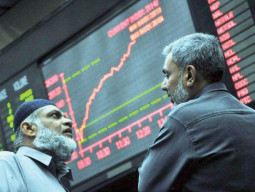
The quantity of gas that gets wasted like this is around 406 million cubic feet per day (mmcfd), that’s 10.5% of the combined production of all gas fields in the country. That’s also enough to run a 1,500 to 2,000-megawatt power plant, technically able to cut electricity shortfall by a third.
At today’s gas price in the domestic market, not the much higher international rate, the cost of this wasted gas comes to over Rs21 billion. Someone has to bear this cost and in this case it is mostly the consumers using stoves at home, buying bread from tandoors or the factories paying a higher tariff.
How much of this should be passed on to the consumers and why shouldn’t the gas distribution companies bear the loss has been an issue that needs more debate. It has also dragged government officials, politicians and stock traders to court in corruption charges.

How it all started?
Pakistan’s piped gas infrastructure is spread over thousands of kilometres. Unlike neighbouring India where even today people in major cities use gas cylinders, piped gas here reached every big town years ago.
But over the years, the two state-controlled gas utilities – Sui Southern Gas Company (SSGC) and Sui Northern Gas Pipelines Limited (SNGPL) – were made to expand piped connection deeper into rural areas as politicians vied to garner support of voters.
As pipeline length grew and more consumers received easy access to gas, monitoring turned into a difficult job, leakages increased and theft became a daily occurrence.
One aspect of this entire expansion is also that the profit of gas utilities is tied with return on fixed assets – the more pipelines they add, the bigger their bottom line. SSGC and SNGPL’s profitability is linked with 17% and 17.5% respective rate of return on their net fixed assets.
The UFG losses weren’t always that huge. In the early 2000s, gas shortage wasn’t that big a worry either. But as consumption increased and it became apparent that reliance on imported oil was not viable, policymakers realised their mistakes like allowing unbridled use of CNG.
SSGC, SNGPL’s peril
From 2004 to 2011, SNGPL’s transmission pipeline network, which brings gas from fields to cities and towns, increased from 5,776 kilometres to 7,613 km. Similarly, its distribution pipeline network expanded from 42,192 km to 82,025 km. SSGC experienced a similar growth trend.
UFG losses are especially high in remote towns and villages where customers are spread over a large area. For SNGPL, its worst region is Gujranwala with 15% loss. In SSGC’s case, it’s Balochistan with 40% loss.
A former senior official of SSGC says the UFG loss also stems from the shift of sales in favour of retail consumers like households and restaurants instead of bulk customers like K-Electric.
“There was a time when the ratio of bulk-retail customer was 60 to 40. Now it’s the other way round.”
In a recent interview, Managing Director Shoaib Warsi said gas theft and pipeline ruptures cause most of the UFG losses.
In smaller towns and even cities, people in instances puncture holes in SSGC’s steel pipelines and then use rubber pipes to run stoves in 50 homes at a time, he said.
Lack of coordination between different civic agencies and haphazard development also contribute to the UFG loss, he said.
“In other countries, the route for underground gas pipelines, electricity wires and telephone lines remains fixed. But here anyone can dig up a road for his own purpose and damage our pipelines.”
Costly imports
To meet the gas shortfall, which has gone beyond 50% of existing supply, the government would be importing liquefied natural gas (LNG) in 2015. Current wellhead gas price is around $4 per mmbtu. Imported LNG will cost over $18 per mmbtu. That’s almost five times over what the consumers are paying.
While government and industry officials are unanimous that there is no quick remedy for the energy crisis except for LNG imports, questions are being raised about who would bear the cost.
“If the LNG goes into the national pipeline system, which loses 10% of its gas to theft and pipeline erosion, then imports don’t make sense,” remarked a senior official.
Published in The Express Tribune, August 11th, 2014.
Like Business on Facebook, follow @TribuneBiz on Twitter to stay informed and join in the conversation.
COMMENTS (6)
Comments are moderated and generally will be posted if they are on-topic and not abusive.
For more information, please see our Comments FAQ



1730959638-0/trump-(19)1730959638-0-165x106.webp)













@Prognosticator: The loss is 10% which means that 90% of gas is paid for. Why are you choosing to define all consumers by the 10% that steal gas versus the 90% that pay for it? Actually the percentage of paying customers is greater than 90% because some of the losses are due to poorly maintained infrastructure not theft.
The way I see it increases in gas prices are inevitable if we are to pay for imported gas. That means a lot of industries will no longer be viable. Fertilizer factories for instance. This will lead to a shift in our industrial base away from such industries.
Pipe line delivary of gas is an insane project. it was blindly started to such gas from Balochistan 1956 & then Sind later. Qatar, Iran and Saudi Arabia which are among top 7 gas producers dont have pipe delivery. pakistan which ranks in top 40 has... pipe gas is necessary in those countries where winter temp goes below -5 regularly. but our country has histry of stealing from Weak i.e Balochistan which is runing countrys economy from 1956 has gas supplies to only 20% of its masses. not to forget Quetta city is 11% of Balochistans population.
Gas delivery through pipes is not for people in the subcontinent where honesty is at a premium. Maybe when we are more developed, we might consider it. If only electricity could also be packed up it cylinders !
Ask the Sher PM-- he is responsible as ten head of the state!
“If the LNG goes into the national pipeline system, which loses 10% of its gas to theft and pipeline erosion, then imports don’t make sense,”
That's why we shouldn't import LNG but CNG. LNG can only be imported in large quantity and unlike CNG can't be unloaded into thousands of small cylinders. CNG can be imported in small quantity and any loss would taken by the importers and CNG stations.
www-minaraway-com
Very instructive article. We need to deal these leakages vas have better monitoring.